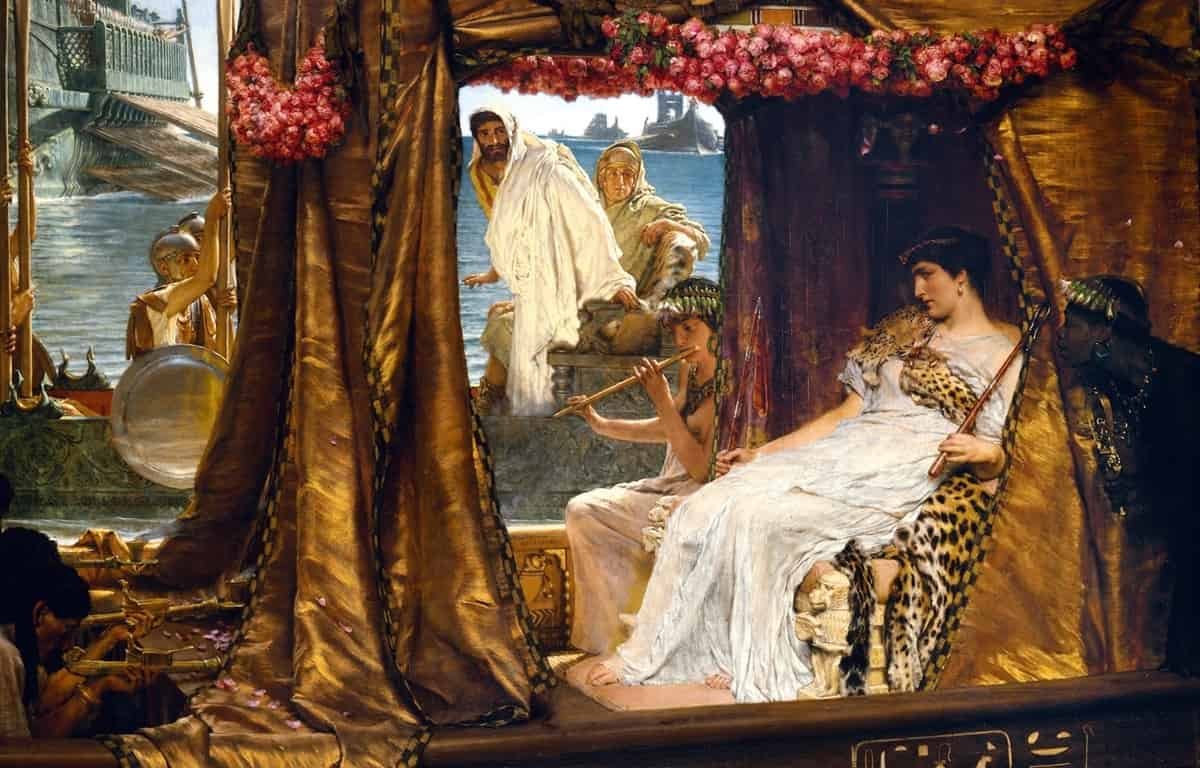Setting the Stage: The Roman Republic in Turmoil
To delve into the compelling story of Mark Antony and Cleopatra, one must first grasp the turbulent context of their time. The Roman Republic stood on the brink of transformative change, teetering between stability and chaos. In 44 BCE, the brutal assassination of Julius Caesar, a pivotal figure in Roman history, unleashed a colossal power vacuum that plunged Rome into political turmoil. With factions in the Senate clashing and ambitious generals vying for dominance, the future of the Republic hung in the balance. Meanwhile, Rome’s vast territories, stretching from Spain to the Middle East, faced not only internal divisions but also the looming threats of external adversaries. This volatile environment would ultimately intertwine with and shape the fates of Antony and Cleopatra, setting the stage for their historic and tragic alliance.
Mark Antony was a seasoned general and a protege of Julius Caesar. He emerged as a charismatic yet controversial figure. Known for his commanding presence and political acumen, Antony carried heavy ambitions. However, he often lacked the restraint needed to navigate Rome’s treacherous political waters. Meanwhile, Cleopatra VII Philopator ruled Egypt as the last monarch of the Ptolemaic dynasty. She was far more than a queen sitting on her throne—profoundly intelligent, a polyglot, and highly adept at political strategy. Under her reign, Egypt faced both internal discord and external threats. In this climate of chaos and ambition, the foundations of their fateful meeting were laid.
The First Encounter: Fates Collide at Tarsus
In 41 BCE, the paths of Mark Antony and Cleopatra intertwined in the historic city of Tarsus, located in modern-day Turkey. Antony, as a ruler of the Eastern Roman provinces, summoned Cleopatra to explain why she had supported his rival after Caesar’s assassination. However, Cleopatra turned what could have been an interrogation into a stage for diplomacy and intrigue by arriving in a majestic procession aboard a gilded barge, draped in purple sails and exuding an aura of divinity, captivating Antony and shifting the dynamic in her favor.
Legend surrounds Cleopatra’s arrival in Tarsus. She is said to have orchestrated an entrance that would indelibly capture Antony’s imagination. Cleopatra approached Tarsus aboard a grand ship clad in golden sails and propelled by oars of silver. The vessel was adorned with luxurious fabrics, flower arrangements, and musicians creating a feast for the senses. Cleopatra herself, portrayed as the goddess Venus incarnate, reclined under a gilded canopy fanned by attendants. Antony, initially astounded by the sheer magnificence of the scene, is described as being both mesmerized and intrigued. The meeting that followed combined diplomacy with spellbinding charm. Cleopatra appealed to both Antony’s sense of duty to Rome and his more personal inclinations.
Antony, enchanted by her intelligence, wit, and beauty, found in Cleopatra almost a mirror of his quest for power and legacy. Little did they know, this encounter would spark a union that would ripple through history, blending politics and passion in equal measure.
Politics and Passion: A Power Couple’s Realm
Their romance soon blossomed into a partnership that captured the imagination as much as it fueled Roman gossip. What set their relationship apart was the intermingling of personal affection and political strategy. Cleopatra, savvy as ever, recognized that aligning with Antony could help secure Egypt’s dominance in a Mediterranean world increasingly dominated by Rome. Antony, in turn, found in Cleopatra a wealth of resources and a political ally for his Eastern campaigns.
Cleopatra played the role of both lover and counselor, sharing her wealth and strategic insights with Antony. Their mutual ambitions extended beyond their immediate realms. Antony sought to consolidate power over Rome and the East, while Cleopatra envisioned a grand empire led by her lineage. The birth of their twins, Alexander Helios and Cleopatra Selene, in 40 BCE cemented their partnership both personally and politically. These children symbolized the union of East and West.
Yet their ambitions would not escape scrutiny and opposition. Many in Rome, especially Octavian (later Augustus), viewed Antony’s relationship with Cleopatra as a betrayal of Roman ideals. Cleopatra’s foreign origins and her perceived influence over Antony stoked fears of Egyptian dominance over Roman affairs. Soon, these tensions would boil over into a full-scale clash.
Turning Tides: The Strife of Actium
The relationship between Cleopatra and Antony reached its political zenith and military nadir during the Battle of Actium in 31 BCE. This decisive event unfolded along the western coast of Greece, pitting Antony and Cleopatra against Octavian’s forces. Salvos of propaganda had already painted Cleopatra as the cunning temptress leading Antony astray. Romans were primed to see this battle not just as a clash of armies but as a defense of Rome itself against foreign domination.
Cleopatra and Antony joined forces both militarily and personally, commanding a joint fleet. However, their strategy faltered amid fatigue, internal betrayal, and Octavian’s superior naval tactics. In a move that has been debated by historians ever since Cleopatra and Antony fled the battlefield mid-fight, their forces descending into chaos. This retreat was not merely a military misstep—it cast a shadow on Antony’s image and underscored their vulnerability.
The Fall from Grace: Love Lost in Despair
The aftermath of Actium marked the slow unraveling of Antony and Cleopatra’s world. Driven back to Alexandria with dwindling resources and morale, they found their once-lofty ambitions in tatters. Octavian’s forces mounted relentless campaigns, pressing closer to the heart of Egypt.
In a cruel twist of fate, Antony, misinformed of Cleopatra’s death, attempted suicide by falling on his sword. Fatally wounded, he was brought to Cleopatra’s side, dying in her arms in a scene of tragic poignancy. Cleopatra, facing the inevitability of capture and humiliation, prepared to meet a similar fate. According to legend, she arranged her death using an asp, its venom delivering a swift and sovereign end.
Their deaths not only marked the collapse of their ambitions but also a turning point in history. Octavian’s victory consolidated his position as Rome’s first emperor, leaving the story of Antony and Cleopatra as a cautionary tale of passion, power, and its perils.
The Legacy of a Timeless Tragedy
Mark Antony and Cleopatra’s story is more than just an epic romance; it is a study of how love and ambition can escalate human potential and hasten ruin. Their lives highlight the interplay of political strategy and personal longing, leaving unanswered questions about the cost of ambition.
Artists, poets, and writers through the ages have drawn inspiration from their lives. William Shakespeare immortalized their story in his play Antony and Cleopatra, portraying their bond as a timeless spectacle of human emotion. It continues to resonate in contemporary media, a testament to its enduring relevance.
Through their highs and lows, triumphs and defeats, their tale asks viewers and readers: how far would one go for love? And does ambition inevitably lead to tragedy? These are timeless questions that keep the story of Antony and Cleopatra alive across generations. What resonates most with you in their tumultuous tale?


